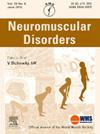New insight in lipid storage myopathy
IF 2.7
4区 医学
Q2 CLINICAL NEUROLOGY
引用次数: 0
Abstract
Lipid storage myopathy (LSM) is a lipid metabolic disorder characterized by the excessive accumulation of lipid droplets within muscle fibers. Classic multiple acyl-CoA dehydrogenase deficiency (MADD), also known as glutaric aciduria type II (GAII), is a clinically heterogeneous group of disorders caused by mutations in the electron transfer flavoprotein (ETF) and ETF-ubiquinone oxidoreductase (ETFQO). Growing evidence suggests that late-onset classic MADD due to ETFQO mutations is a primary cause of LSM. In addition to classic MADD, MADD-like disorders have also been identified as contributing factors to LSM, as supported by numerous studies. This review summarizes recent advances in the clinical, pathological, biochemical, and molecular features, as well as treatment outcomes, of LSM with various etiologies, with a particular focus on the latest findings regarding MADD-like disorders.
脂质储存性肌病的新认识
脂质储存性肌病(LSM)是一种以肌肉纤维内脂滴过度积聚为特征的脂质代谢紊乱。经典多重酰基辅酶a脱氢酶缺乏症(MADD),也称为戊二酸尿症II型(GAII),是一种由电子转移黄蛋白(ETF)和ETF-泛醌氧化还原酶(ETFQO)突变引起的临床异质性疾病。越来越多的证据表明,由ETFQO突变引起的迟发性经典MADD是LSM的主要原因。除了经典的MADD之外,许多研究也支持了类似mad的疾病也被确定为LSM的因素。本文综述了各种病因的LSM的临床、病理、生化和分子特征以及治疗结果的最新进展,并特别关注了与mad样疾病有关的最新发现。
本文章由计算机程序翻译,如有差异,请以英文原文为准。
求助全文
约1分钟内获得全文
求助全文
来源期刊

Neuromuscular Disorders
医学-临床神经学
CiteScore
4.60
自引率
3.60%
发文量
543
审稿时长
53 days
期刊介绍:
This international, multidisciplinary journal covers all aspects of neuromuscular disorders in childhood and adult life (including the muscular dystrophies, spinal muscular atrophies, hereditary neuropathies, congenital myopathies, myasthenias, myotonic syndromes, metabolic myopathies and inflammatory myopathies).
The Editors welcome original articles from all areas of the field:
• Clinical aspects, such as new clinical entities, case studies of interest, treatment, management and rehabilitation (including biomechanics, orthotic design and surgery).
• Basic scientific studies of relevance to the clinical syndromes, including advances in the fields of molecular biology and genetics.
• Studies of animal models relevant to the human diseases.
The journal is aimed at a wide range of clinicians, pathologists, associated paramedical professionals and clinical and basic scientists with an interest in the study of neuromuscular disorders.
 求助内容:
求助内容: 应助结果提醒方式:
应助结果提醒方式:


